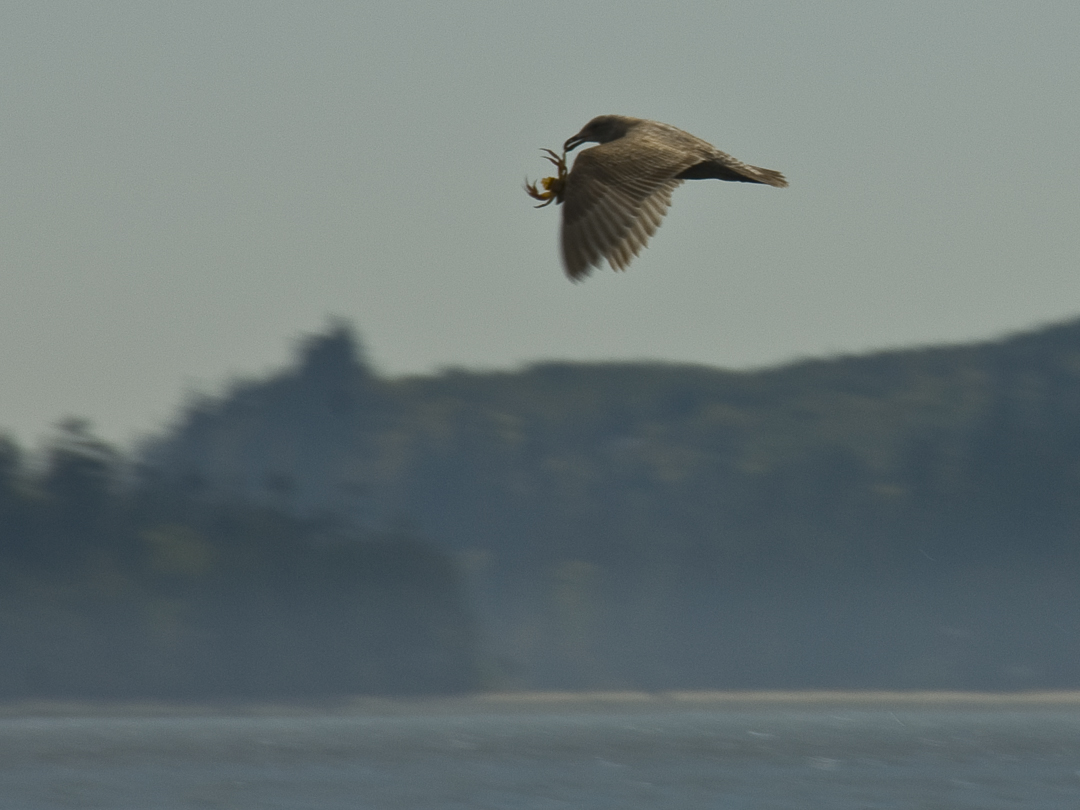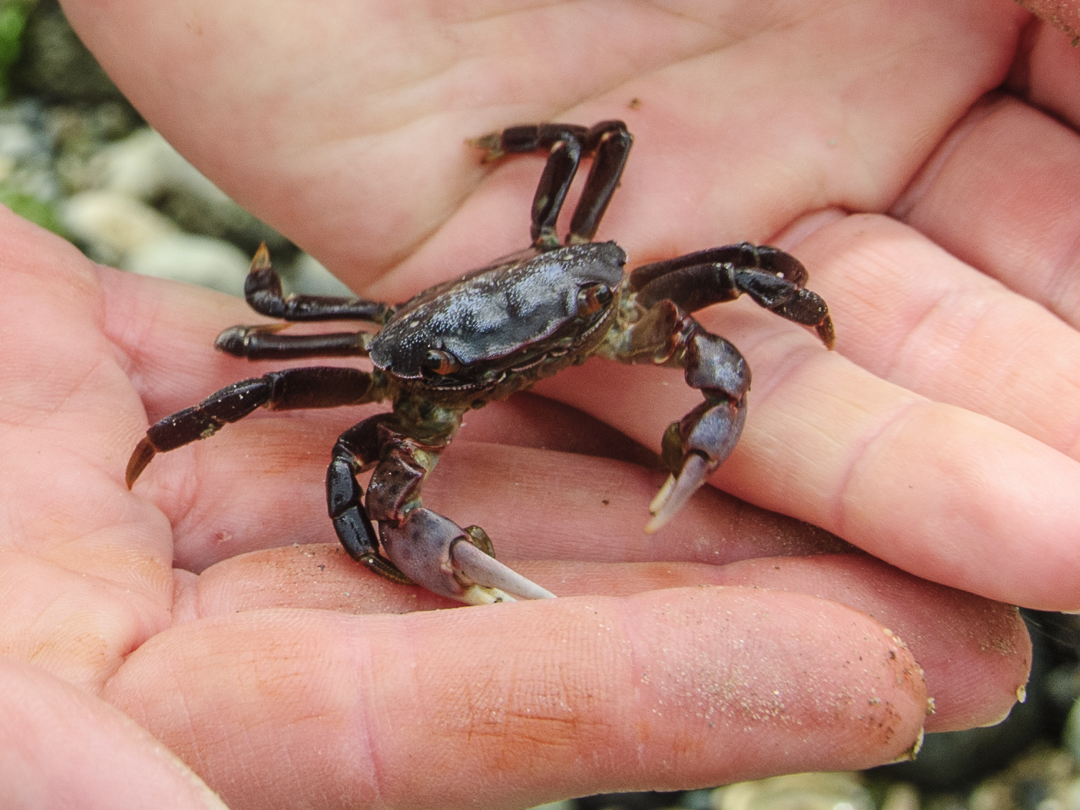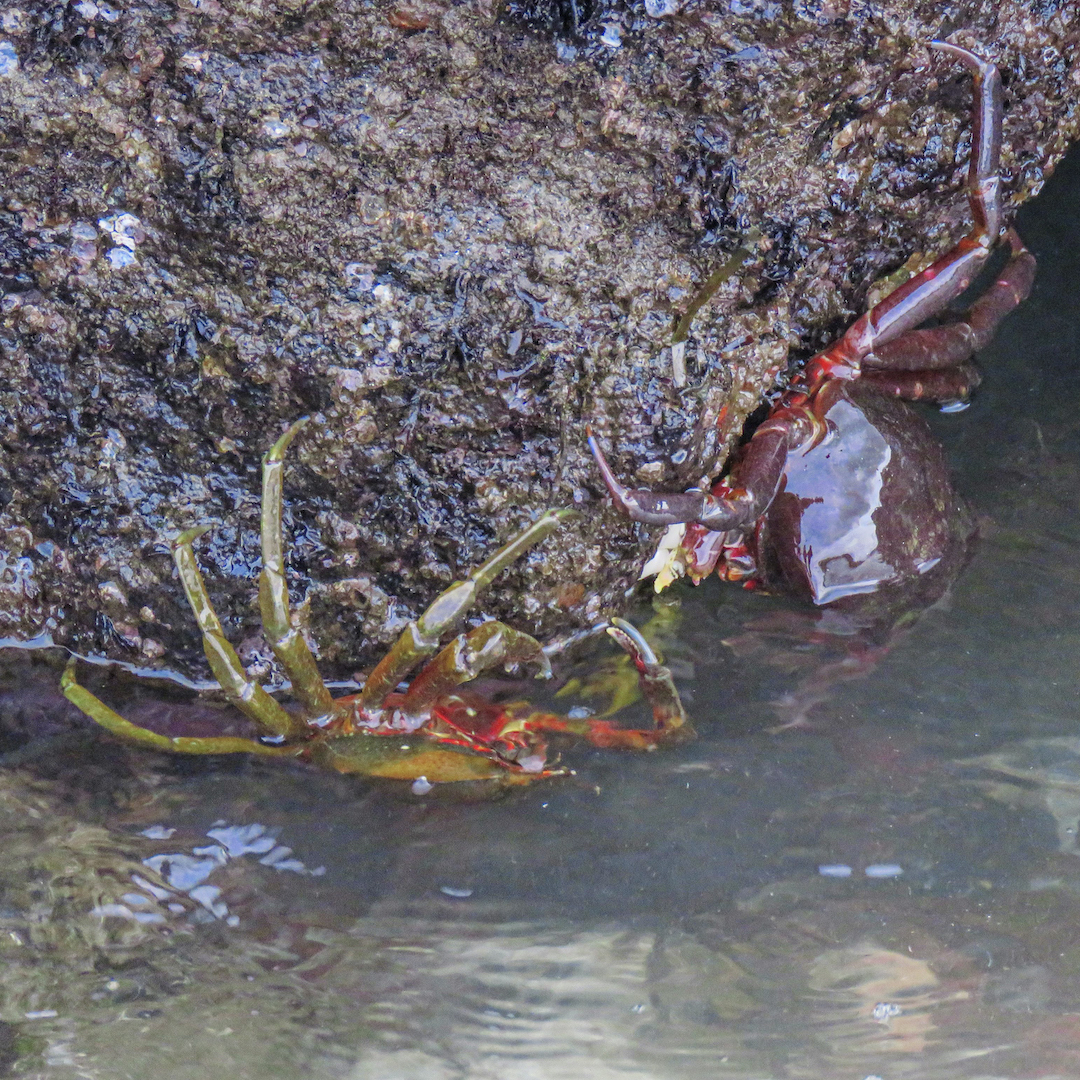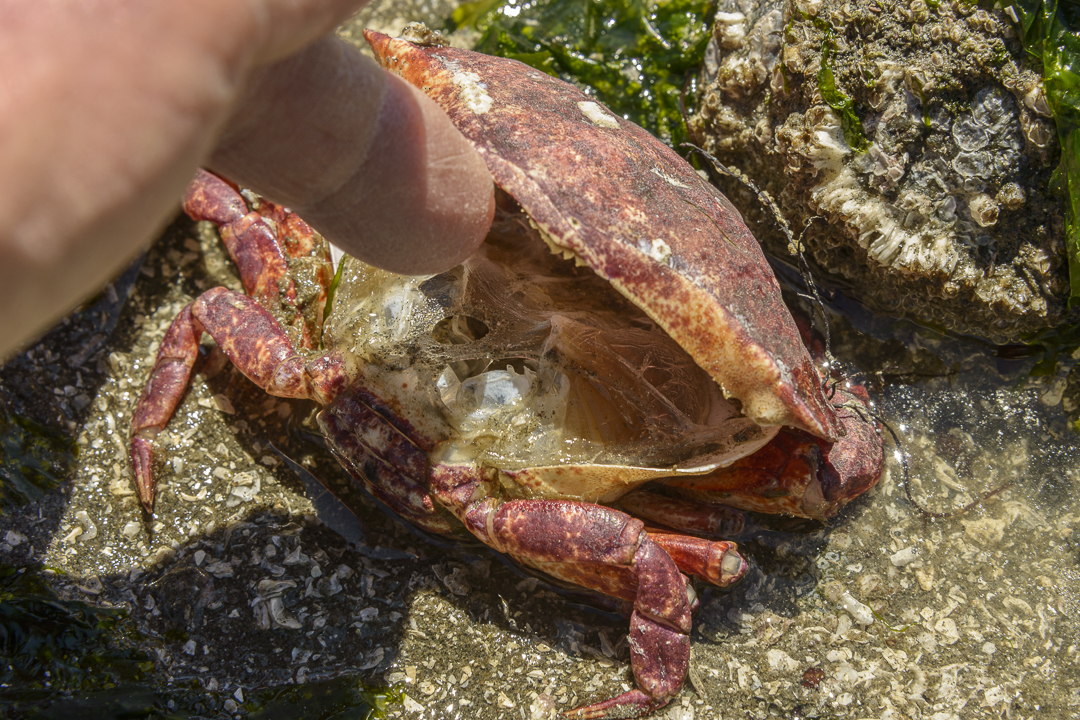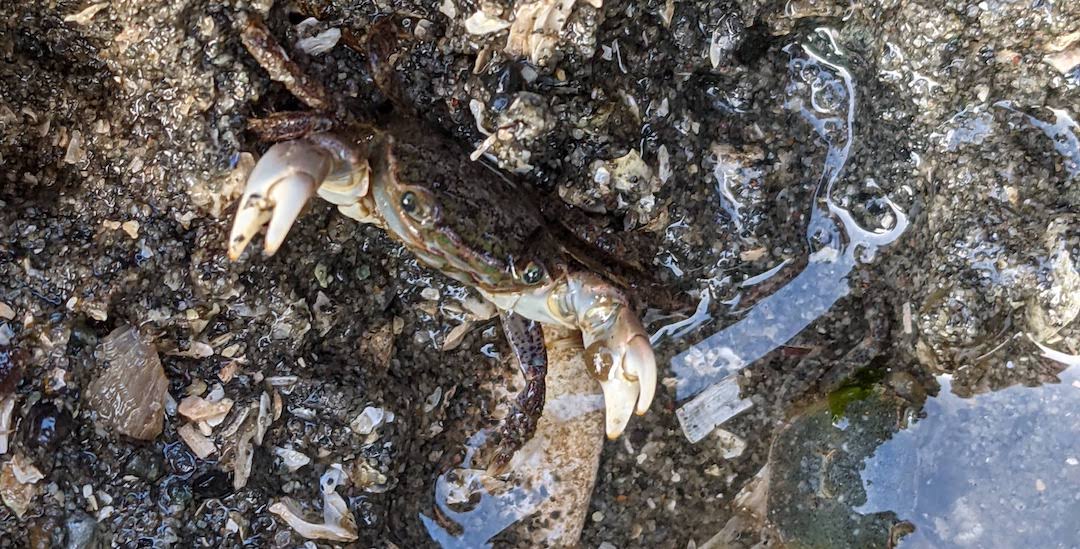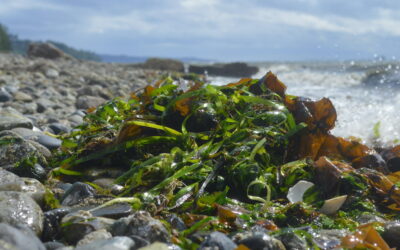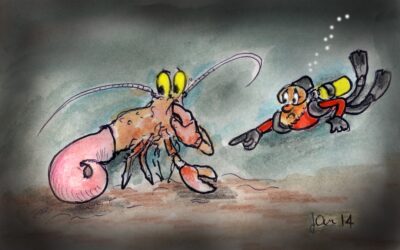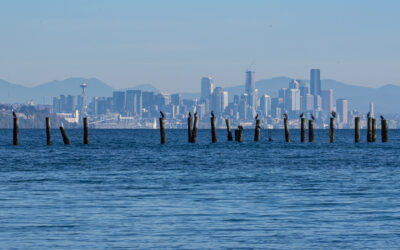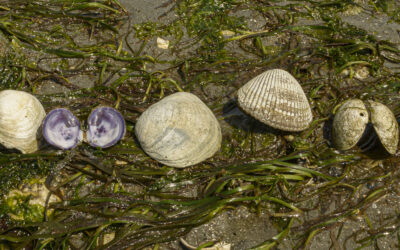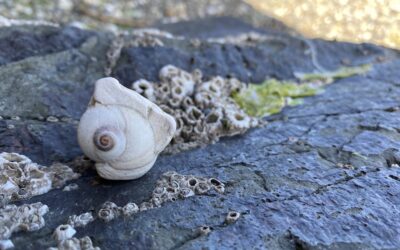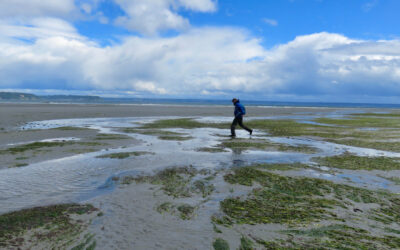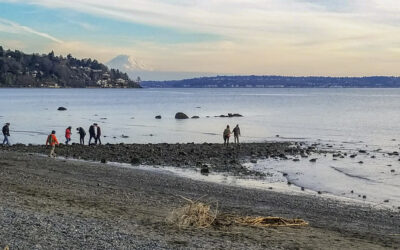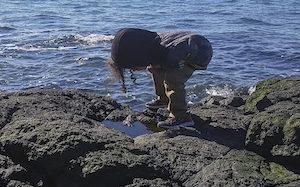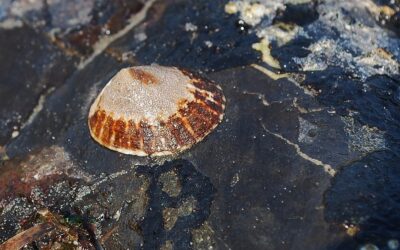A RAINBOW OF CRABS
by Laura Marx, Summer 2021
fact-checked by Greg Jensen
photo by John F. Williams
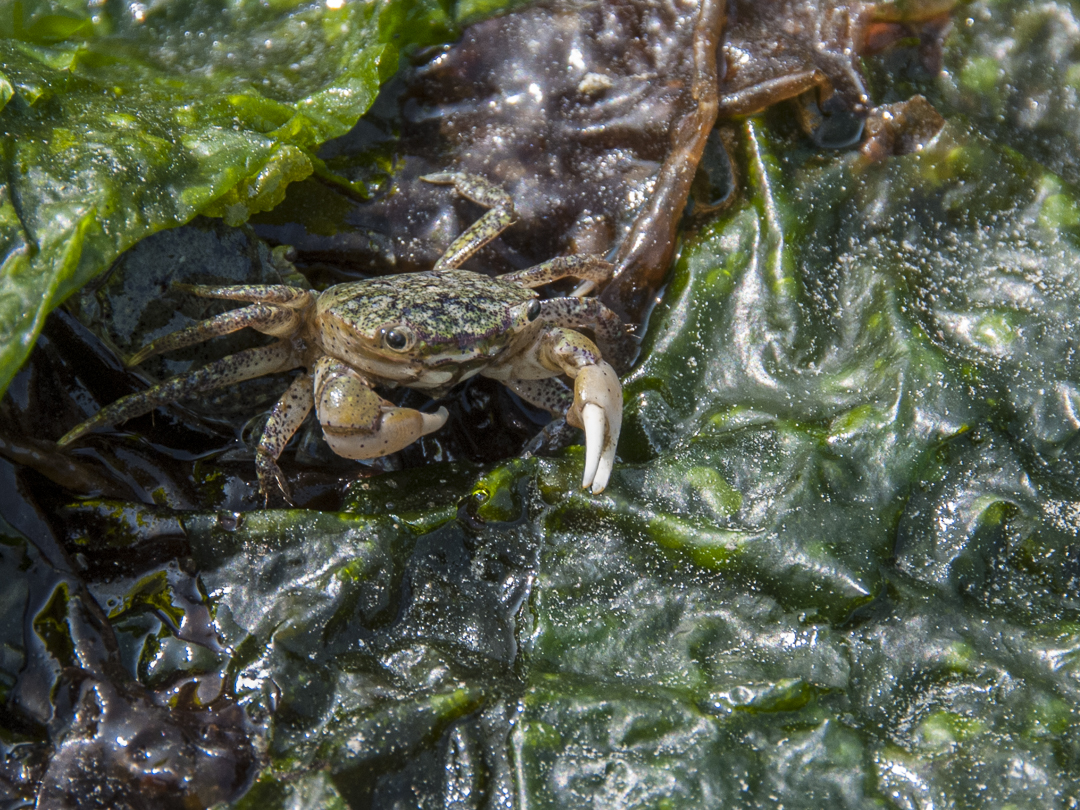
photo by John F. Williams
A RAINBOW OF CRABS
by Laura Marx, Summer 2021
fact-checked by Greg Jensen
On a Saturday in early March, in an attempt to shake off the last of the winter lockdown slump, my partner and I took advantage of the rare sunny day and headed to Constellation Park in West Seattle to explore the shore and soak up a bit of vitamin D. It was low tide in the afternoon — the perfect time to observe the activity of creatures dwelling on the rocky shore.
The intertidal zone, composed of different microhabitats and conditions that are constantly changing due to the tides, is exposed during low tide and submerged during high tide. This habitat is full of a variety of animals that make their home, and the Pacific Northwest intertidal zone is particularly rich in diversity. Each species that lives on the shoreline has adapted to fill a specific niche in order to survive and thrive.
And if you’re interested in finding some crabs, you’re sure to be in luck if you know where to look! Crabs prefer to be out of sight and are masters at seeking out the best hiding spots. On the rocky shore, crabs burrow into the sand, between rock crevices, and under rocks and vegetation.
We carefully turned over rocks to uncover shore crabs, young rock crabs, and hermit crabs all gathered for shelter in a miniature ecosystem left behind by the receding tides. This is the perfect place for defenseless juveniles of various species to hang out and feed on microorganisms until they are large enough to venture out into the big world. However, the shore crabs we found were actually not juveniles — shore crabs generally only reach a maximum size of about two inches.
Our first large find above the rocks was an impressive northern kelp crab, easily identifiable by its smooth, teardrop-shaped shell and spider-like appearance. This individual was missing an arm, likely from surviving an encounter with a shorebird, octopus, or maybe even a sea otter. Immature crabs can lose limbs and regenerate them when they molt, a tactic that helps them survive as common prey animals. However, adult spider crabs (including kelp and decorator crabs) don’t molt, and they can’t regenerate lost limbs.
They are an essential food source for many larger animals. Depending on the species, adult crabs have a few other strategies for defense against predators — the most obvious being their hard carapaces (outer covering) and pinching claws. If you are brave enough to pick up a crab, do so carefully — make sure your hands are out of reach of those claws, or you might regret it!
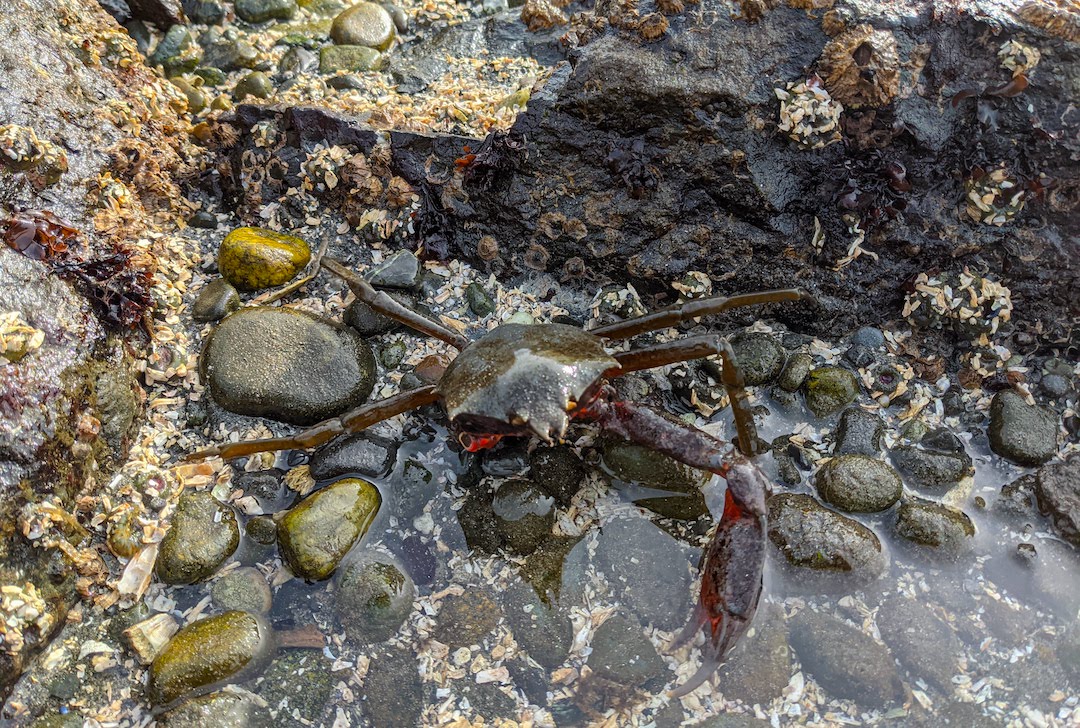
This kelp crab lost a leg likely escaping a situation with a predator. photo by Laura Marx
Kelp crabs can vary in coloration based on their diet. These crabs seemed to be competing for the same rock. photo by Laura Marx
As we continued to explore, we were captivated by a show of six kelp crabs that seemed to be fighting over prime real estate between two large rocks, scrambling to keep hold of the rock wall as waves rushed over them. Kelp crabs use their long, pointy legs to aid them in gripping onto kelp and avoid being swept away by the waves, and they can be territorial. It makes sense they’d exhibit the same behavior above water.
Kelp crabs get their names for multiple associations with kelp. Not only are they well camouflaged by their coloration, they also feed on kelp, mostly during the summer when it is most plentiful. Their coloration even comes from the type of kelp they eat — red or green. In the winter they feed opportunistically and might change their diet to mussels and barnacles when kelp is less abundant.
 Here’s a link to a very brief video showing a kelp crab in its natural underwater environment (except for the videographer).
Here’s a link to a very brief video showing a kelp crab in its natural underwater environment (except for the videographer).
On our way out, we stumbled upon a large red rock crab, distinguishable by its deep reddish coloration and impressively large claws. Its pincers are not just for show — this is a carnivorous species that uses its claws to crack open shelled organisms such as barnacles, clams, and snails to eat. True to its name, it prefers to shelter nestled amongst the rocks in the intertidal zone.
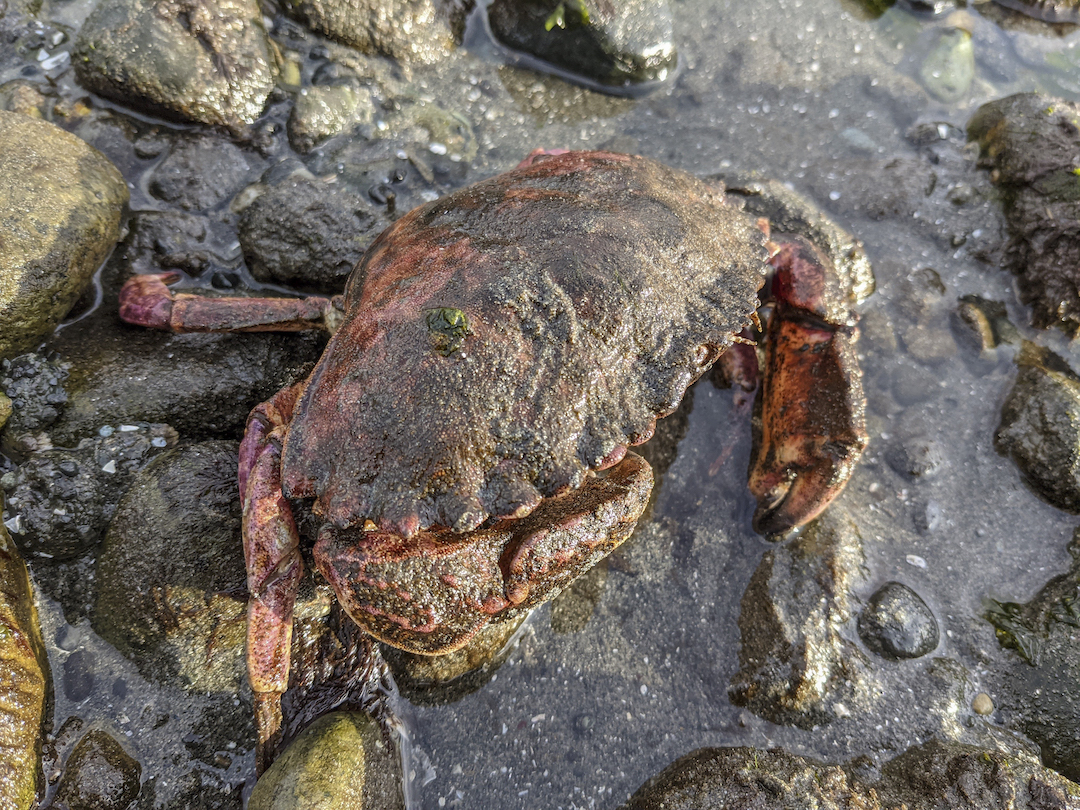
Red rock crabs are easy to identify due to their bright coloration. photo by Laura Marx
A few weeks later, we went on another venture to the beach at Carkeek Park in Seattle. While we dodged a city of geoducks spraying our ankles, we kept an eye out for critters. Just ahead of us, a flock of hungry seagulls picked through the beach, also keeping an eye out for critters, though for different reasons. This time, we didn’t have as much luck finding many new species of crab. We did find some perfectly intact crab molts. Like all arthropods, crabs must shed their exoskeletons (hard outer covering) in order to grow. We also found many little shore crabs scuttling away or burying themselves in the sand as we peeked under rocks, replacing them gently.
As we circled back, we came upon the grand finale of our crab observations — a Dungeness crab, half buried in the mud. The Dungeness crab is a well known local, named after Dungeness, a community on Washington’s Olympic Peninsula. Related to the red rock crab, the Dungeness crab can be differentiated by its lighter colored claws and large size. The one we found was around eight inches across its armored back. Dungeness crabs are generally found in deeper water, so this was a special find. This individual was a large male guarding a female in a precopulatory embrace. You can see part of the front of the female in the photo.
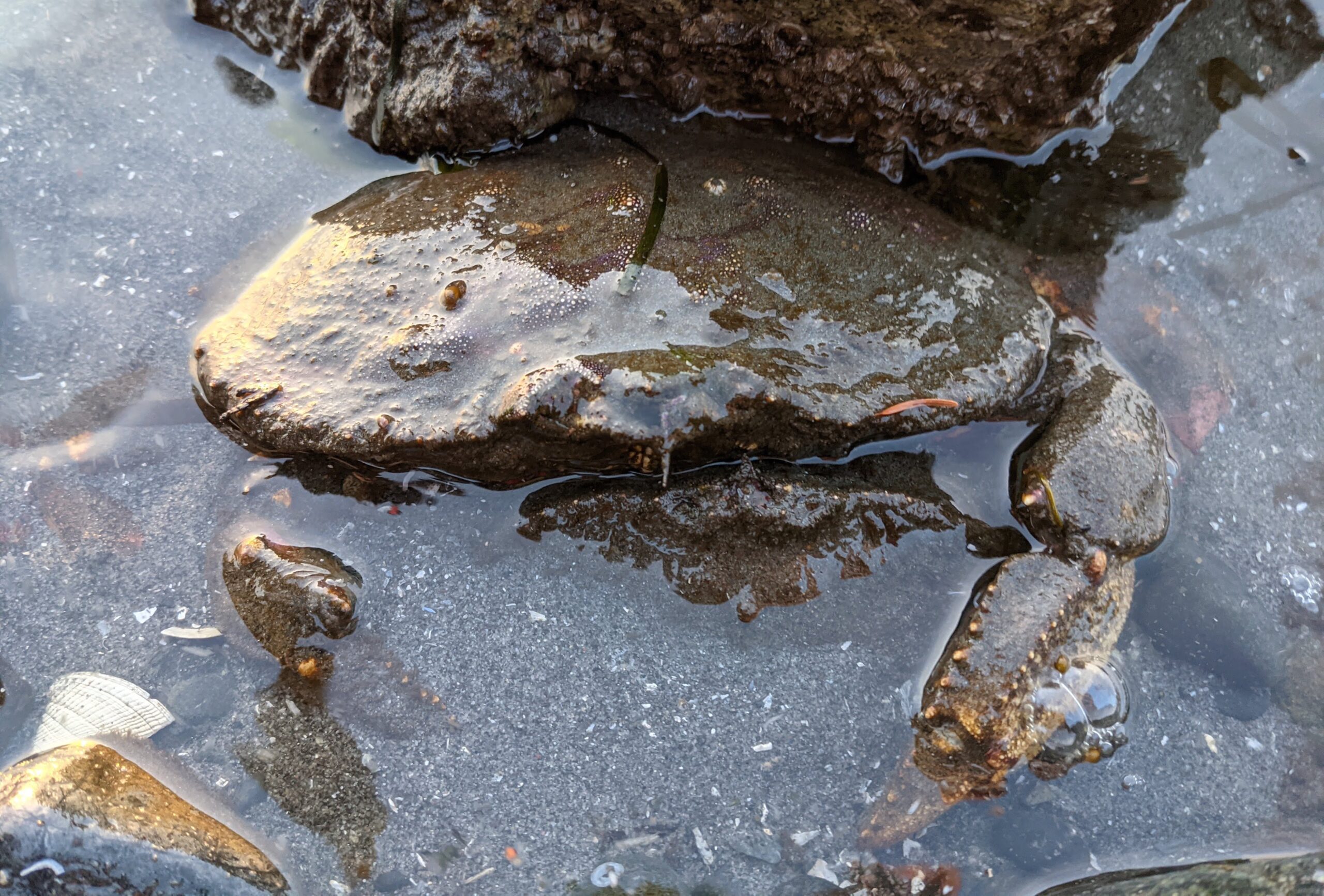
This Dungeness crab was a large male guarding a female in a precopulatory embrace. photo by Laura Marx
The next time you take a walk on a Northwest beach, keep an eye out for the kaleidoscope of color and diversity of crustaceans you might find! Plan ahead by looking up the tide times before your visit, and be aware of where you step. One of the biggest causes of damage to intertidal zones is trampling by people who are unaware that each step has a consequence. Even though they may seem rocky and indestructible, beaches are fragile natural areas that many creatures call home.

Laura Mariko Marx is a recent resident of Seattle but is loving everything about living in the majestic Pacific Northwest. She attributes her love for wildlife to having grown up in San Diego, a city that gave her exposure to animals, conservation issues, and the outdoors. Laura is currently a botany interpreter at The Spheres in Seattle and a volunteer at the Seattle Aquarium. In her spare time, she enjoys writing, reading, yoga, arts and crafts, hiking, SCUBA, and spending time with her partner and their house full of pets.
FIND OUT MORE
Table of Contents, Issue #12, Summer 2021
Beach Wrack
by Nick Baca, Summer 2021 photos by Nick Baca except as notedby Nick Baca, Summer 2021 photos by Nick Baca except as notedOn a warm sunny day, the shores of Puget Sound are filled with the smell of rotting seaweed. Flies are heard before they are seen, swarming above...
Hermit Crabs
by Sadie Bailey, Summer 2021 photos and drawings by Jan Kocian fact checked by Greg Jensenby Sadie Bailey, Summer 2021 photos and drawings by Jan Kocian fact checked by Greg Jensen The waves fly onto the beach as if they were racing each other. Which one can...
Piling Up
by Jeff Adams, Summer 2021 photos by Jeff Adams except as noted fact checked by Andy Lambphoto by John F. Williamsphoto by John F. Williamsby Jeff Adams, Summer 2021 photos by Jeff Adams except as noted fact checked by Andy LambAs a marine ecologist and nature...
RVs of the Beach
by Tom Noland, Summer 2021 photos by Tom Noland except as noted fact-checked by Greg Jensenby Tom Noland, Summer 2021 photos by Tom Noland except as noted fact-checked by Greg JensenWalking the shore of Cama Beach State Park on one of the lowest tides in recent...
Shell Shapes
by Chris Rurik, Summer 2021photo by Sarah Cavanaughphoto by Sarah Cavanaughby Chris Rurik, Summer 2021 Photos by Sarah CavanaughI have a collection of broken shells. They litter my desk and drawers, wave-smoothed fragments of curves and spirals, half-bleached, like...
Moon Snails at Low Tide
by Marilyn DeRoy, Summer 2021 Photos & video by Marilyn DeRoyBy Marilyn DeRoy, Summer 2021 Photos & video by Marilyn DeRoyAt the end of May, we had two days of minus 3.8’ (minus 1.15 m) tides at the northern end of the Kitsap Peninsula; wonderful for...
Poetry-12
Summer 2021Photo by Jessica C. LevinePhoto by Jessica C. LevineSummer 2021To begin this section of poetry, here are three haikus which speak to our excessive heat this summer.by Drea Dangerton Cold water absentDrive belt for water massesFrayed, hardly churning...
Hello Under There
Proper Etiquette for Exploring the Beach by Sarah Lorse, Summer 2021 photo by Kaylani Siplinphoto by Kaylani SiplinProper Etiquette for Exploring the Beach by Sarah Lorse, Summer 2021 At first glance, the beaches along the Salish Sea may seem desolate, except for the...
Home Sweet Home
by Barbara Erickson, Summer 2021 Photos by Barbara Erickson except as noted by Barbara Erickson, Summer 2021 Photos by Barbara Erickson except as notedWHOOPEE! With the approach of summer and loosening of COVID restrictions, it’s time to head out exploring! For me,...
PLEASE HELP SUPPORT
SALISH MAGAZINE
DONATE
Salish Magazine contains no advertising and is free. Your donation is one big way you can help us inspire people with stories about things that they can see outdoors in our Salish Sea region.
We also don't advertise Salish Magazine, so please spread the word of this online resource to your friends and colleagues.
Thanks so much for your interest and your support.
We also don't advertise Salish Magazine, so please spread the word of this online resource to your friends and colleagues.
Thanks so much for your interest and your support.

